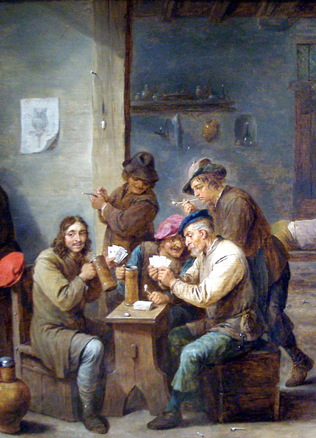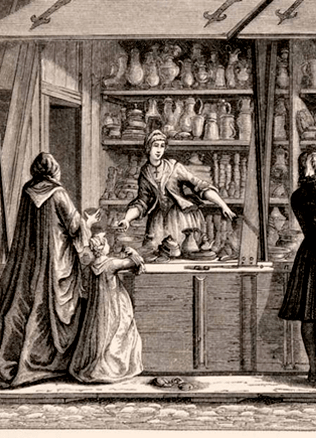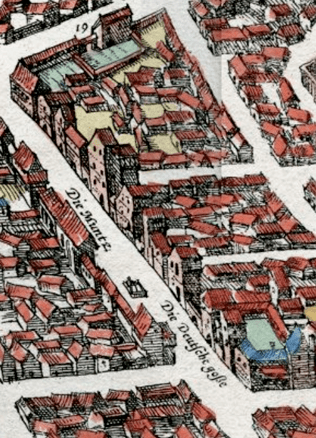Privileged intermediaries: early communities of merchants in Lithuania
Trade was the most important expression of the activity of an economic community in the pre-industrial epoch. Merchants were the most mobile strata of the town-dwellers in the Middle Ages and the early modern times, which successfully took over and spread the achievements of civilisation in every-day life, ensured a constant circulation of novelties and cultural influences. Their commercial journeys and financial activities contributed to the intensity of the economic and cultural life of the town. The largest European cities attracted merchants from remote districts to their markets and fairs who exchanged their cultural experience when trading too. Therefore, contacts between the merchants enriched material and spiritual culture of everyday life of the town-dwellers and even that of the nobility. In the late Middle Ages the merchants were assigned functions of postmen, confidential agents, diplomats, informers, scouts and creditors. Merchants carried large amounts of money and served the rulers and other state officials in any other ways.
Vilnius: a thread between the East and the West
Merchant communities in the largest cities of Lithuania ensured functioning and continuity of trade. Vilnius merchants played an especially significant role in the country’s trade. The important trade overland route ran through the town, which led via Polotsk and Smolensk to the lands of the state of Moscow. This route linked trade spaces of Moscow, Central and Western Europe. Vilnius merchants were granted exclusive rights during the time of Algirdas’ reign (1345–1377). The Grand Duke exempted Vilnius merchant from the customs duty in the whole territory of the state. Later the Grand Dukes who ruled after Algirdas repeated this right.
Do You Know?
From the 14th century an abundant community of German merchants headed by Hanul who was from the town of Riga lived in Vilnius. German merchants settled near the Church of St Nicholas in Vilnius. The name of the Church (St Nicholas was the patron of the merchants) shows that it was a house of worship of Christian merchants. The present-day German’s Street in Vilnius also testifies to the fact that people of this nationality lived there.
Soon the capital of the Grand Duchy of Lithuania became a trade centre where merchants from the East, Central and Western Europe used to meet.
The earliest data about the merchant communities that formed in Lithuania reached us from the 14th century. Merchants united in a community, which had its original organisation and guaranteed safety to its members. Traditionally the Ruler was a patron of foreigners. In Lithuania, the agreements concluded with the Teutonic Order during the years of Vytautas’ reign (beginning with the Treaty of Salynas in 1398) defined mutual freedom of the merchants to trade without new customs duties and the duty of the Ruler was to take care of them. Most probably the concept of taking care of the merchants was known and applied in pagan Lithuania already because from the 14th century an abundant community of German merchants headed by Hanul who was from the town of Riga lived in Vilnius. German merchants settled near the Church of St Nicholas in Vilnius. The name of the Church (St Nicholas was the patron of merchants) shows that it was a house of worship of Christian merchants. The present-day German’s Street in Vilnius also testifies to the fact that people of this nationality lived there.
An abundant community of Ruthenians existed in Vilnius alongside the German merchants. It was Vygantas who mentioned civitas Ruthenica (a city of the Ruthenians) in his chronicle, and “the great town-dwellers” (miestiče velikie) mentioned in one chronicle most probably were the Ruthenians. Looking from the present-day Town Hall to the left, one can see a great density of Orthodox churches, only a small part of which has survived, but it also testifies to the fact that once there were many Ruthenians there. Russian’s Street also reminds us of the existence of the Ruthenian community.
From the 14th century the German and Ruthenian communities formed the economic life of Vilnius. The merchants of the town maintained relations with other merchants who reached the Netherlands, Flanders, England via Gdansk and on the other side – Great Novgorod. At the end of the 14th century Vilnius appeared in the descriptions of Hansa routes prepared for the merchants travelling to the East through Prussia and Poland. A group of merchants was formed in Gdansk, which communicated with the merchants of the Grand Duchy of Lithuania. It consisted of the members of the Town Council, diplomats and military characters of Gdansk. In maintaining strong relations with foreign partners Vilnius merchants occupied high positions in the local society. For example, Piotr Goskowicz maintained close relations with the brethren, and his nephew Andrius even became the Bishop of Vilnius (1481–1491). The Laurinavičiai family also occupied a high position in Vilnius (they had land ownership in their disposition, fulfilled the duties of Prefect).
Kaunas: a confluence of commercial arteries
The merchants of the town of Kaunas were active in the Grand Duchy of Lithuania and beyond its borders. After the Treaty of Raciąż was concluded in 1404, favourable conditions for them to settle in the town were created. Goods supplied by Lithuania also encouraged the invasion of the merchants in Kaunas. The Treaty of Nešava signed by Władysław II Jagiełło and the Teutonic Order in 1424, which guaranteed freedom of movement across the Grand Duchy of Lithuania, Poland and the lands of the Order, also had an impact on the merchants’ settlement in Kaunas. From 1440-1441, the Hansa merchant Office operated in Kaunas, and merchants from the so-called Prussian towns (Gdansk, Torun, Elbing) began to arrive in the town more and more often. In summer and autumn river flotilla reached Kaunas, which carried salt, the most important commodity to the market of the Grand Duchy of Lithuania.
At the beginning of the 15th century the merchant community of the town of Kaunas consisted mainly of the German arrivals. This is testified to by their surnames. In 1414, the list of debtors compiled by the Commendator of Brandenburg of the Teutonic Order mentions the following debtors: the Prefect of the town Niclos Trintel and the town-dwellers Jacob czu Garbow, Ulrich Czenger. All of them were merchants, active and mobile persons who had relations in the state of the Order, and were engaged in international and local trade.
The town of Kaunas constantly received attention from the merchants of other Lithuanian towns.
If the merchants wanted to go to Danzig or other Prussian towns, they could not bypass Kaunas. In 1410–1411, not only the merchants of Kaunas, but also those of Vilnius, Trakai and Krėva were indebted to the Commendator of Brandenburg. The linking artery, which created favourable conditions for the town of Kaunas to survive, was the Nemunas River and its tributary the Neris. Merchant vessels sailed in both rivers. The largest town of the country Vilnius was reached by the Neris River, and in the 15th century a chain of cities and small towns was already located along the middle and upper reaches of the Nemunas River. Punia, Merkinė and Gardinas were the most important among them. The Šventoji, the tributary of the Neris, and the Nevėžis, which fell into the Nemunas, were navigable rivers used for trade. The towns of Ukmergė, Anykščiai and Kėdainiai were built on them.
In the 15th – at the beginning of the 16th century, the town-dwellers, Christians and the Karaites carried out active trade in Kaunas. The latter were found in the towns of Prussia too, they also traded with Hansa merchants in Lithuania. In 1494, the inhabitants of Kaunas complained that the merchants of Trakai traded in small articles and did harm to the interests of the merchants of Kaunas.
The feature that distinguished the town of Kaunas from other Lithuanian towns was the fact that the Hansa merchant Office formed there (the Hansa merchant Office also functioned in Polotsk).
The formation of the Hansa merchant Office in Kaunas was a result of the competition with the local merchants. In 1445–1448, the merchants of Danzig had already the regulations of the organisation approved by the Council of Danzig in Kaunas. The documents of 1450 mention the chief of the merchants of Kaunas (Lat. prepositus mercatorum de Kawn) for the first time, and in 1470 the Ruler of Lithuania and Poland Casimir approved the Rgulations of the Hansa merchant Office in Kaunas. Hence, the Office was strengthened from above – by the will of the Ruler. Alongside the community of the merchants of Kaunas, an office organised by the Hansa cities in which the merchants of Danzig formed the majority emerged.
Arvydas Maciulevičius



